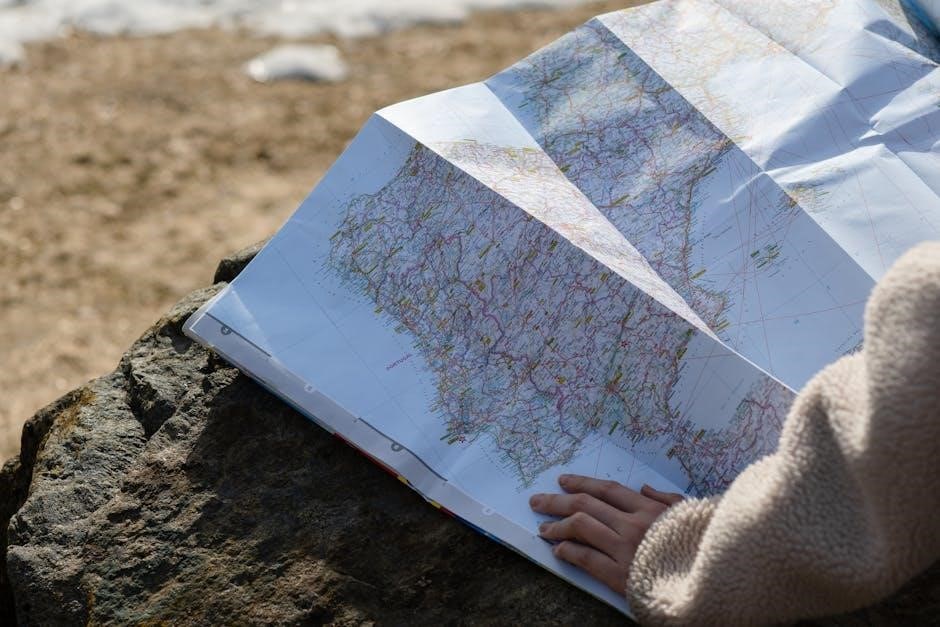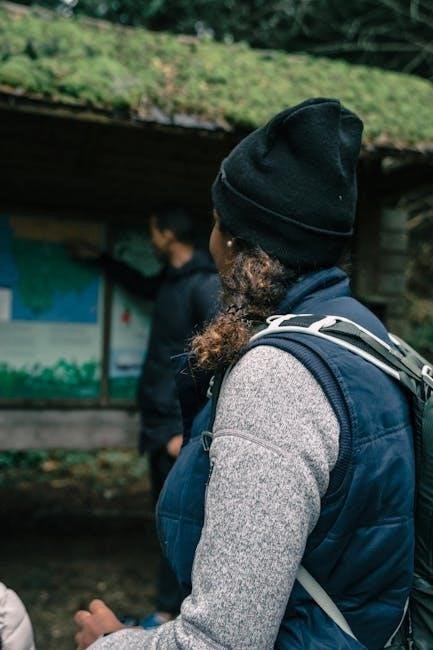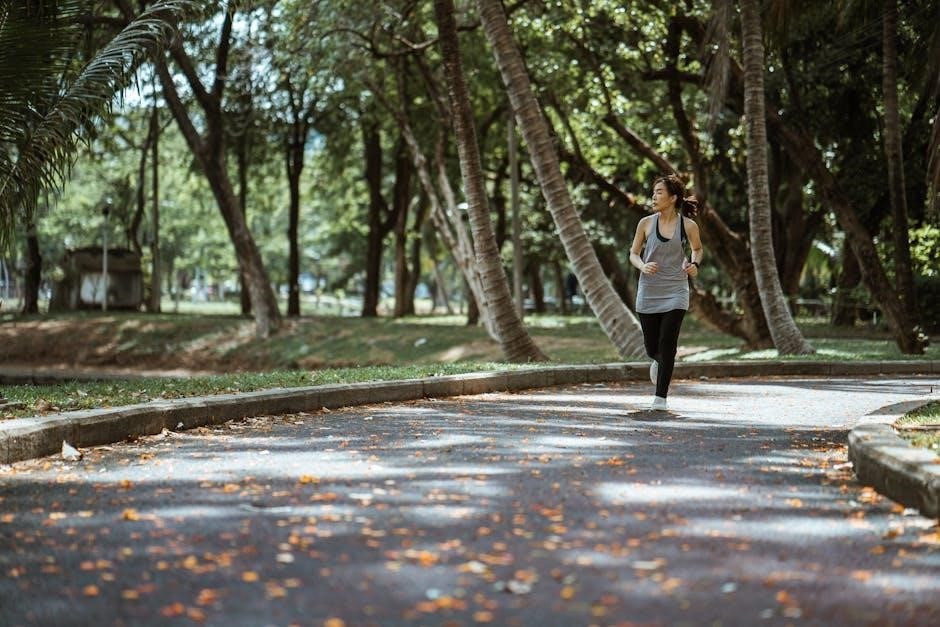Overview of “Trail Guide to the Body”
This acclaimed book is a hands-on guide to musculoskeletal anatomy and palpation, aiding healthcare providers and students in precise body structure location and understanding.
Trail Guide to the Body is a renowned, hands-on guide authored by Andrew Biel, designed to help students and professionals master musculoskeletal anatomy and palpation. The book offers a clear, step-by-step approach to locating muscles, bones, and other structures, making anatomy accessible and practical. Its unique trail metaphor and detailed illustrations provide an engaging and effective learning experience for those in healthcare and manual therapy fields.
1.2 Key Features and Benefits
The book features detailed illustrations, a user-friendly format, and a trail metaphor for learning anatomy. It provides exclusive access to free study tools, enhancing learning. Biel’s expertise ensures precise palpation techniques, benefiting healthcare professionals and students. The guide’s practical approach and visual aids make it an essential resource for understanding the body’s musculoskeletal system effectively.

Author Background: Andrew Biel
Andrew Biel is a licensed massage therapist with expertise in musculoskeletal anatomy. His work, “Trail Guide to the Body,” has significantly impacted manual therapy education.
2.1 Professional Credentials and Expertise
Andrew Biel is a licensed massage therapist with extensive knowledge in musculoskeletal anatomy. His professional background includes hands-on clinical experience, which he leverages to create practical, accessible educational materials. Biel’s expertise lies in translating complex anatomical concepts into clear, actionable guidance, making him a respected figure in manual therapy and anatomy education.
2.2 Motivation for Writing the Guide
Andrew Biel wrote Trail Guide to the Body to simplify the learning of musculoskeletal anatomy. His goal was to bridge the gap between theoretical knowledge and practical application, making anatomy accessible to students and professionals. By creating a clear, hands-on guide, Biel aimed to empower healthcare providers and educators with the tools to master palpation and enhance their clinical skills effectively.
Structure and Content of the Book
The book is organized as a step-by-step guide, leading readers through musculoskeletal anatomy with clarity. Its user-friendly approach combines detailed instructions with illustrations for effective learning.
3.1 The Trail Metaphor in Learning Anatomy
The trail metaphor transforms anatomy learning into a step-by-step journey, guiding readers through musculoskeletal structures with clarity. This approach breaks down complex anatomy into manageable, interconnected pathways, enhancing understanding and retention. By simulating hands-on exploration, it helps learners visualize and locate muscles, bones, and other tissues effectively, making the study of anatomy both intuitive and engaging for students and professionals alike.
3.2 Comprehensive Coverage of Musculoskeletal Anatomy
The book provides an in-depth exploration of musculoskeletal anatomy, detailing muscles, bones, tendons, ligaments, and fascia. Its thorough descriptions enable learners to understand the location, function, and interrelationships of each structure. This comprehensive approach ensures that students and professionals alike can confidently identify and palpate anatomical landmarks, making it an indispensable resource for both academic and practical applications in healthcare and bodywork fields.

The Role of Palpation in the Guide
The book emphasizes palpation as a vital skill for identifying musculoskeletal structures, providing clear techniques to enhance precision and confidence in hands-on practice.
4.1 Techniques for Effective Palpation
The guide offers step-by-step methods for precise palpation, including proper hand placement, pressure control, and systematic exploration of muscles, bones, and ligaments. These techniques empower learners to confidently identify anatomical structures, ensuring accurate assessments and effective treatment plans in clinical settings.
4.2 Practical Applications in Healthcare
The guide is widely used by physical therapists, massage therapists, and other healthcare professionals to enhance diagnostic accuracy and treatment effectiveness. Its clear techniques improve palpation skills, aiding in injury assessment, pain relief, and rehabilitation. The book supports evidence-based practices, making it an indispensable tool for improving patient outcomes in clinical and therapeutic settings.

Visual Aids and Illustrations
The guide features detailed, full-color illustrations that simplify complex anatomy, making it easier for students and professionals to understand and apply palpation techniques effectively.
5.1 Importance of Illustrations in Anatomy Learning
Illustrations in anatomy learning are crucial for visualizing complex structures. They provide a clear, concise representation of muscles, bones, and ligaments, aiding in better retention and understanding. In “Trail Guide to the Body,” the detailed visuals complement the text, making palpation techniques and anatomical locations more accessible for students and professionals alike. This enhances hands-on learning and clinical application significantly.
5.2 Unique Visual Elements in the Book
Renowned for its clarity and precision, the book’s unique visual elements, such as color-coded illustrations and 3D-style imagery, enhance the learning experience. These visuals guide students through complex anatomical structures, making it easier to identify and understand their relationships; The detailed, user-friendly design supports both academic study and hands-on clinical applications effectively.
Target Audience and Uses
This guide is essential for students, healthcare professionals, and bodyworkers. It serves as both an academic resource and a practical tool in clinical environments.
6.1 Primary Audience: Students and Healthcare Professionals
Trail Guide to the Body is primarily designed for students of anatomy, massage therapy, and healthcare professionals. Its clear, step-by-step approach makes it ideal for learners seeking to master musculoskeletal anatomy and palpation skills. The book is widely used in educational settings, offering practical tools for understanding human anatomy. It supports hands-on learning, making it indispensable for both classroom and clinical environments.
6.2 Use in Educational and Clinical Settings
Trail Guide to the Body is widely adopted in anatomy courses and clinical training programs. Its practical approach enhances hands-on learning, making it a valuable resource for palpation practice. Healthcare professionals use the guide for quick reference, while educators integrate it into curricula for comprehensive musculoskeletal education. This versatility ensures its effectiveness in both academic and real-world applications, bridging theory with practice seamlessly.

Study Tools and Resources
Trail Guide to the Body offers exclusive access to a range of study tools, including digital resources, interactive quizzes, and practical exercises for enhanced learning.
7.1 Companion Materials for Enhanced Learning
Andrew Biel’s Trail Guide to the Body provides students with a comprehensive suite of companion materials. These include detailed flashcards, step-by-step video tutorials, and interactive quizzes. Additionally, users gain access to a digital atlas of musculoskeletal structures, enhancing their ability to visualize and understand complex anatomical concepts. These resources are designed to reinforce hands-on learning and make studying more engaging and effective.
7.2 Digital Resources and Accessibility
The book is supported by extensive digital resources, including interactive anatomy videos and downloadable study guides. These tools are accessible via a dedicated website, ensuring easy access for students. The digital materials are compatible with various devices and web browsers, making learning flexible and convenient. This integration of traditional and digital learning enhances the overall educational experience for users of Trail Guide to the Body.

Reception and Impact
Trail Guide to the Body has received widespread acclaim and awards, becoming a cornerstone in manual therapy education and significantly influencing the way anatomy is taught and understood.
8.1 Reviews and Awards
Trail Guide to the Body has garnered stellar reviews for its clarity and practicality, earning it awards and recognition as a leading resource in manual therapy education. Widely praised by professionals and students, it is celebrated for its ability to make complex anatomy accessible. The book’s innovative approach has solidified its reputation as a cornerstone in the field of musculoskeletal anatomy and palpation training.
8.2 Influence on Manual Therapy Education
Trail Guide to the Body has revolutionized manual therapy education by providing a structured, step-by-step approach to learning anatomy. Its emphasis on palpation and hands-on learning has set a new standard, inspiring curricula worldwide. Educators and students alike credit the book with enhancing practical skills and fostering a deeper understanding of the human body, making it an indispensable tool in the field.

Comparisons with Other Anatomy Guides
Trail Guide to the Body surpasses other anatomy guides with its user-friendly design, detailed illustrations, and practical palpation techniques, making it a standout resource for hands-on learning.
9.1 Unique Selling Points
Trail Guide to the Body stands out with its hands-on approach, detailed palpation techniques, and user-friendly design. Its emphasis on practical anatomy, paired with exclusive study tools and digital resources, makes it an invaluable resource for students and professionals, distinguishing it from other anatomy guides.
9.2 How It Stands Out in the Market
Trail Guide to the Body excels with its practical, hands-on approach and detailed palpation techniques. Its unique trail metaphor, comprehensive coverage, and user-friendly format make it a favorite among students and professionals. The inclusion of exclusive study tools and digital resources further enhances its appeal, positioning it as a leading resource in anatomy education and manual therapy training.
The Author’s Philosophy on Anatomy and Touch
Andrew Biel emphasizes the integration of anatomy and palpation, believing touch enhances understanding and clinical effectiveness, fostering a deeper connection with the body’s structures for better care;
10.1 Integration of Anatomy and Palpation Skills
Andrew Biel’s philosophy centers on merging anatomy with palpation, creating a holistic approach that enhances understanding and clinical effectiveness; By combining tactile exploration with anatomical knowledge, students and professionals gain a deeper appreciation of musculoskeletal structures, improving diagnostic accuracy and therapeutic outcomes. This integration emphasizes hands-on learning, making complex anatomy accessible and applicable in real-world scenarios.
10.2 Promoting a Deeper Understanding of the Body
Biel’s guide fosters a profound connection between theoretical knowledge and practical application, empowering learners to appreciate the body’s intricate design. By emphasizing palpation and anatomical detail, the book encourages a mindful approach to understanding human structure, enhancing both clinical skills and personal body awareness. This deeper understanding translates to improved patient care and a lifelong appreciation of anatomy.

The Evolution of the Book
Trail Guide to the Body has evolved through updated editions, enhancing content and adding study tools to better serve learners in anatomy and palpation.
11.1 Updates and New Editions
Trail Guide to the Body has undergone several updates, with new editions incorporating feedback from professionals and students. Each edition enhances clarity, expands content, and adds visual aids to improve learning. The latest versions include digital resources, making it more accessible for modern learners. These updates ensure the guide remains a cutting-edge tool for anatomy and palpation education.
11.2 Feedback from Readers and Professionals
Readers and professionals praise Trail Guide to the Body for its clarity and practicality. Many highlight its effectiveness in enhancing palpation skills and musculoskeletal understanding. Feedback often emphasizes the book’s user-friendly approach and detailed illustrations, making it indispensable for both students and practitioners. Positive reviews frequently mention how the guide has become a cornerstone in anatomy education, fostering confidence and competence in hands-on therapies.

The Role of “Trail Guide to the Body” in Modern Education
The guide is widely adopted in educational curricula, supporting hands-on learning and enhancing understanding of musculoskeletal anatomy. It remains a popular resource for both students and professionals.
12.1 Adoption in Curricula
Trail Guide to the Body is widely adopted in educational curricula due to its clear, interactive approach to teaching anatomy. Its user-friendly design and logical structure make it accessible to students, while its focus on palpation and musculoskeletal anatomy bridges the gap between theoretical knowledge and practical application. The book is often integrated into massage, physical therapy, and medical programs, enhancing hands-on learning experiences.
12.2 Supporting Hands-On Learning
Trail Guide to the Body excels in supporting hands-on learning by providing detailed, step-by-step palpation techniques. Its clear instructions guide students through locating muscles, bones, and joints, reinforcing tactile skills. The book’s practical focus enhances the connection between anatomy knowledge and real-world application, making it an invaluable resource for developing manual therapy and clinical skills effectively.
Testimonials and Success Stories
Readers praise Trail Guide to the Body for its transformative impact on their careers, sharing stories of enhanced skills and confidence in anatomy and palpation practice.
13.1 Stories from Students and Practitioners
Students and practitioners share inspiring stories of how Trail Guide to the Body transformed their understanding of anatomy. Many credit the book with improving their palpation skills, enhancing clinical confidence, and fostering a deeper connection to the human body. Professionals highlight its practicality, while students appreciate its clarity and accessibility, making it an invaluable resource for both education and career advancement in healthcare fields.
13.2 How the Book Has Impacted Careers
Trail Guide to the Body has significantly impacted careers in healthcare, enabling professionals to enhance their palpation skills and anatomical knowledge. Many practitioners credit the book for advancing their clinical expertise, leading to promotions and new opportunities. It has also empowered students to enter the workforce with confidence, solidifying its reputation as an indispensable tool for career growth and professional development in manual therapy and related fields.

The Future of Anatomy Education
The book is shaping the future by integrating hands-on learning with digital tools, fostering deeper anatomical understanding and practical skills for healthcare professionals and students alike.
14.1 Trends in Anatomy and Palpation Training
Modern anatomy education emphasizes hands-on learning and digital integration. Trail Guide to the Body aligns with these trends by offering practical palpation techniques and interactive study tools. Its clear, step-by-step approach has set a new standard for musculoskeletal training, making complex anatomy accessible to students and professionals alike. This shift toward experiential learning is reshaping how future healthcare providers master anatomical knowledge and palpation skills.
14.2 The Role of “Trail Guide to the Body” in Shaping the Future
Trail Guide to the Body is a cornerstone in advancing anatomy education. By blending detailed illustrations with practical palpation techniques, it equips learners with essential skills. Its accessible approach has made it a preferred resource in classrooms and clinics, ensuring future generations of healthcare professionals are well-prepared to understand and work with the human body effectively.
Trail Guide to the Body is a transformative resource in anatomy education, offering practical skills and deep insights. Its impact ensures continued relevance and value for learners worldwide.
15.1 Summary of the Book’s Importance
Trail Guide to the Body is a foundational resource for understanding musculoskeletal anatomy and palpation. Its clear, hands-on approach makes complex anatomy accessible to students and professionals. By bridging anatomy and touch, it enhances both theoretical knowledge and practical skills, ensuring its enduring value in education and healthcare. Its comprehensive coverage and accessibility solidify its role as an essential tool for learners worldwide.
15.2 Final Thoughts on Its Value to Readers
Trail Guide to the Body empowers readers with a deep understanding of musculoskeletal anatomy and palpation, making it an invaluable resource for both students and professionals. Its clear, engaging approach ensures practical application in real-world settings, while its comprehensive study tools enhance learning. This book not only educates but also inspires a lifelong appreciation of anatomy, leaving a lasting impact on careers and patient care.
